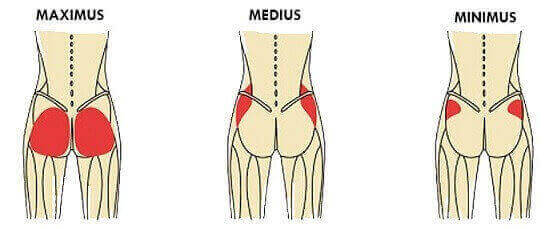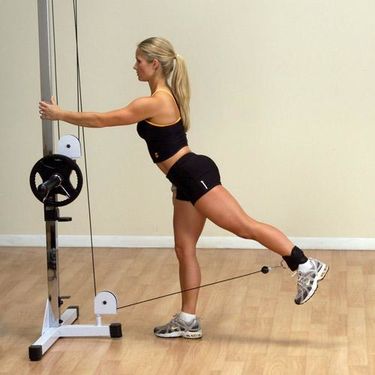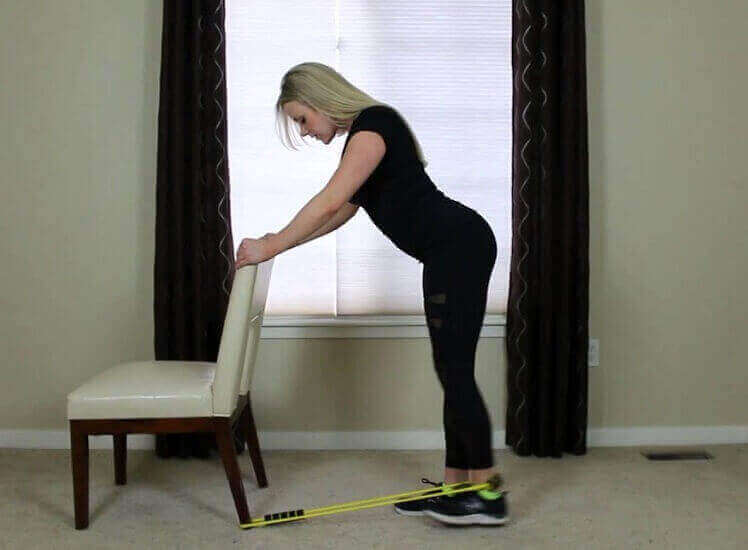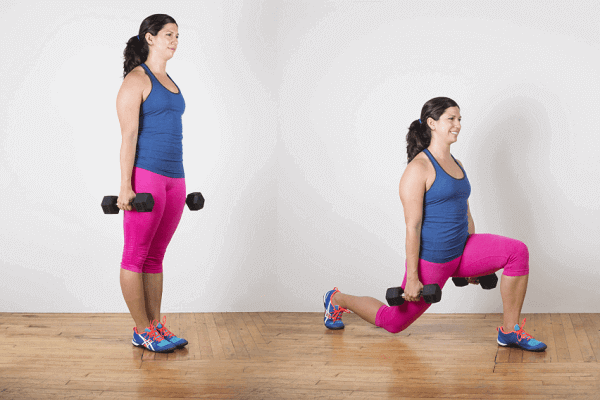The Cable Glute Kickback is an effective workout and provides great results for the gluteal muscles.
In my research and analysis, I have found that there is a great demand for body fitness, especially for glute exercises to either stabilize the core body or to get a great butt shape.
So this article is dedicated to highlighting and focusing more on these major muscles and how to workout using Cable Glute Kickback.
What is Cable Glute Kickbacks?
Cable Kickbacks is a cable exercise that primarily targets the glutes and helps the legs develop and strengthen the gluteal muscles. It targets the butt and hips together, and also helps shape the legs and the rest of the lower body.
One must know that the buttocks are among the largest muscles and consist of 3 gluteal muscles, Gluteal Maximus (the largest), Medius and Minimus. Here the Gluteal Maximus helps in dictating the proper posterior shape of butt and is responsible for the movement of the thigh and the rotation of the legs.

The other two important muscles, they are shorter and work in such a way that they can provide the best support for the Maximus while the movement of the legs to either side.
Make sure you have the skill and better muscle coordination because this exercise is more difficult than than seems look, but the end result of the routine will give you maximum benefits, with the tone and shape of your buttocks.
Given all the information, this step-by-step guide for the Cable Glute Kickback will provide much more than what was discussed above. So, look deeper to get the best out of the cable workout.
Are Cable Glute Kickbacks Effective?
If you are asked this question, this exercise is actually effective and useful for improving the shaping of the glutes (buttocks) and legs. It is especially helpful for the hamstrings or the back leg of each.
The exercise helps create a full and round butt as it is most parts are targeted where the hamstrings meet the buttocks. It also helps build posterior strength, which also translates to providing better functionality and performance, altogether for the lower body.
If you look at athletic performance, a better, higher jump is an indicator of butt strength.
How to Do a Cable Glute Kickback?
Using a cable glute machine in the gym or a tubing band at home, is one of the tools that can easily perform this exercise if you follow the right way.
Before starting, in the gym, be sure to tie the cuff around the ankle during the performing and stand directly in front of the cable pulley machine or where the tube is attached.
If you exercise at home, one may also need a band with a cuff too (bigger one) for the ankle and to attach the band, a sturdy pole or any other secured stable furniture may work.
If one is planning to get the most out of this exercise, make sure to do it properly like any other exercise. Being too arched back or positioned your foot wrongly, you could end up hurting your lower back. So make sure you check the steps correctly before starting your workout.
Doing Standing Cable Glute Kickback Exercise

If you are trying to use a Cable Glute Kickback at the gym, make sure you have a cable rolling machine with a low cable pully and if one can find or have an ankle attachment, it would be great if one continues.
Only if this is not available, use either the regular handle (if the foot can be tucked into it or an ankle strap).
Start with the ankle strap and make sure that the pulley is facing you and that the clip is attached to the ankle. For the rest, follow the steps:
- Be sure to step back a bit as this will help to feel the resistance while workout. Use the other leg, hold the pole or tower for the maintain the support. If there was a machine with a built-in handle, it would be great to use.
- Once you are ready, bend your knees slightly by keeping the Abs contract.
- Slowly kick the leg to back until the hip is extended and once the glutes contracted.
- Keep the focus on squeezing the glutes slightly by holding it down for 1 to 2 seconds and then returning to the starting position.
Try to aim for about 12 to 15 repetitions before moving on to the next stage. Follow the same routine steps. Make sure to give yourself a 40-60 second break before continuing.
If you follow it correctly, you will be able to do about 3 sets of the same steps each time.
Resistance Band Glute Kickbacks while Standing at Home
If you want to perform the glute kickback exercise at home, and you can’t afford a cable machine, you still have a chance to perform it efficiently with a banded tube, which will provide you the required resistance power we need, similar like a cable machine, even with a different resistance level.
All you have to do, just to shorten the resistance band used for exercise more and more every time you want a hard and more resistance workout. Brilliant!

Regarding the steps is also super easy to perform.
- Attach the band to a sturdy, stable pole or any heavy, secure chair at the lowest end near the ground.
- Attach the other band end cuff around the one ankle.
- Follow the same steps for exercising with the cable machine mentioned above in the article to the end of workout.
Cable Glute kickbacks Muscles Worked
There are two main important muscles involved during cable kickback – the gluteal (Maximus, Medius, and Minimus) and Hamstring.
The kickbacks first target the gluteus maximus and hamstrings and then engage the other glutes of both layers.
The core also gets an engagement here to stabilize and keep the body in balance, during the steps of exercise and movement.
Cable Glute kickback Alternative
Dumbbell lunges
Before you begin, make sure you have enough space in front of you, enough for one big step.
Choose from a pair of light to medium dumbbells weights, which enable you to finish your workout sets in order to ensure a highly effective training.

- First, stand on a mat (optional) with a straight back, holding a pair of dumbbells with a hammer grip.
- Keep your arms parallel for each side of your body.
- Place your legs about shoulder width apart.
- Inhale and take a big one step forward with your leg, by bending your knee 90 degrees, so that your thighs are parallel to the ground.
- While bending your back leg at the knee.
- Reverse back the forward Step to the starting position while breathing.
- Switch to the other leg and repeat the same steps.
- You can perform between 5-8 set of lunges.
Bulgarian Split Squat – Alternative of Leg Extension
This is another great exercise that engages the gluteal and leg muscles using a barbell and a bench or small box. Steps are the following:
- While you’re standing, grab a bar and place it on your back at the level of your shoulders like a back squat.
- Bring one leg back and place your toes to be vertical above a bench or small box.
- Then squat by bending your front legs knee to 90 degrees, so that your back legs knee is almost touching the ground.
- Hold this position for seconds, then return the front leg to the original standing position to be straight.
- Repeat the steps and switch to another leg.
Cable Glute kickback Benefits
Why you need to follow a cable kickback routine?
For the glutes, a focused movement on the glutes is the best exercise you can get. It is a very focused and controlled exercise.
Ensures that the gluteal muscles work in isolation to ensure toned legs are built while the posterior glutes is built with a full look.
It’s an assumption that only squats and lunges help build strong gluteal muscles. Although they do the same thing, they do not isolate, nor do they ensure that only the glutes are worked as they also combine with many other muscles, which is built during the workout.
But it’s another way with a focused buttocks workout that helps with isolation and focus on muscle resistance leading to full development and glute muscle recruitment as well.
It is known that while standing, climbing stairs or jumping involves the use of the gluteal muscles, and if it is weak, it may cause poor posture, or unexplained pain in the thigh and knee.
Gluteal weakness can also cause lower back pain. Being unable to stand on one leg with heel pain and at certain times can also increase inflammation.
Therefore, by using the Cable Glute Kickback, one can ensure improved mobility, strength and flexibility. Since the target area being focused here is specific and small, one can easily perform the movements without requiring too many other parts of the body to be engage.
EitherEither way, it’s one of the great moves, and remember, weaker glutes add to the physical performance impact that could ruins our daily lives, in case we don’t pay enough attention to these muscles.
Conclusion
I hope by now you are familiar with how to improve your body physics shape by performing cable kickbacks using the cable pulley system, which add an effective impact exercise that helps re-shape the butt and helps strengthen the muscles of the legs as well.
Lower body exercise should also become a part of your daily routine for your legs and buttocks. Make sure to perform it daily.
